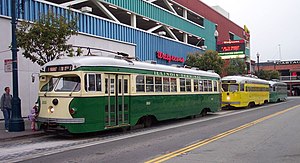
Back PCC BS PCC (koncepce tramvaje) Czech PCC-Wagen German Tramway PCC French Tram tipo PCC Italian PCCカー Japanese Presidents' Conference Committee-tram Dutch PCC (sporvogn) NB PCC (tramwaj) Polish Tramvai PCC Romanian
| PCC streetcar | |
|---|---|
 Three PCCs on the San Francisco Municipal Railway's F-line. Pictured are an example of one double-ended streetcar and two single-ended cars. | |
 Interior of a PCC car | |
| In service | 1936–present |
| Manufacturer | St Louis Car Company Pullman Standard |
| Constructed | 1935–1952 (US) 1949–1978 (Europe) |
| Number built | 5,000+ |
| Number preserved | 328+ |
| Capacity | 52–61 seats |
| Specifications | |
| Car length | 46–50.5 ft (14.02–15.39 m) |
| Width | 100–108 in (2.54–2.74 m) |
| Maximum speed | 50 mph (80 km/h)[citation needed] |
| Weight | 35,000–42,000 lb (15,900–19,100 kg) |
| Traction motors | 4 × 55 hp (41 kW) motors, 43:6 (≈7.17) gear ratio |
| Acceleration | Variable, Automatic 1.5–4.75 mph/s (2.41–7.64 km/(h⋅s)) |
| Deceleration | Service: Variable to 4.75 mph/s (7.64 km/(h⋅s)), Emergency: 9.0 mph/s (14.5 km/(h⋅s)) maximum |
| Electric system(s) | 600 V DC from overhead catenary |
| Current collector(s) | Pantograph or trolley pole |
| UIC classification | Bo'Bo' |
| AAR wheel arrangement | B-B |
| Braking system(s) | Dynamic Service Braking; Friction; for Final Stop, Park; Magnetic |
| Track gauge | 5 ft 2+1⁄2 in (1,588 mm) and other broad gauges 4 ft 8+1⁄2 in (1,435 mm) standard gauge 1,000 mm (3 ft 3+3⁄8 in) and other narrow gauges |
The Presidents' Conference Committee (PCC) is a streetcar design that was first built in the United States in the 1930s. The design proved successful domestically, and after World War II it was licensed for use elsewhere in the world where PCC based cars were made. The PCC car has proved to be a long-lasting icon of streetcar design, and many remain in service around the world.